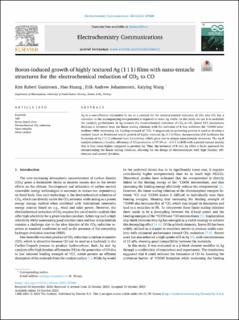| dc.contributor.author | Gustavsen, Kim Robert | |
| dc.contributor.author | Huang, Hao | |
| dc.contributor.author | Johannessen, Erik Andrew | |
| dc.contributor.author | Wang, Kaiying | |
| dc.date.accessioned | 2024-04-08T11:49:43Z | |
| dc.date.available | 2024-04-08T11:49:43Z | |
| dc.date.created | 2023-10-31T12:51:08Z | |
| dc.date.issued | 2023 | |
| dc.identifier.citation | Gustavsen, K. R., Huang, H., Johannessen, E. A., & Wang, K. (2023). Boron-induced growth of highly textured Ag (111) films with nano-tentacle structures for the electrochemical reduction of CO2 to CO. Electrochemistry Communications, 156, Artikkel 107600. | en_US |
| dc.identifier.issn | 1388-2481 | |
| dc.identifier.uri | https://hdl.handle.net/11250/3125285 | |
| dc.description.abstract | Ag is a cost-effective alternative to Au as a catalyst for the electrochemical reduction of CO2 into CO, but a reduction in the accompanying overpotential is required to make Ag viable. In this study we use B to modulate the catalytic performance of Ag towards the electrochemical reduction of CO2 to CO. Initial DFT simulations discloses a deviation from the linear scaling relations with the inclusion of B that stabilizes the *COOH intermediate while weakening the binding strength of *CO. A magnetron co-sputtering process is used to develop a catalyst based on B-induced crystal growth of highly textured Ag (1 1 1) films. Incorporation of B facilitates the formation of Ag (1 1 1) coherent twin boundaries, which gives rise to unique nano-tentacle structures. The Ag-B catalyst achieves a faradaic efficiency of CO production of 97.9% at −0.9 V vs RHE with a partial current density that is four times higher compared to pristine Ag. Thus, the inclusion of B into Ag offers a facile approach for circumventing the linear scaling relations, allowing for the design of electrocatalysts with high faradaic efficiencies and current densities. | en_US |
| dc.language.iso | eng | en_US |
| dc.rights | Navngivelse 4.0 Internasjonal | * |
| dc.rights.uri | http://creativecommons.org/licenses/by/4.0/deed.no | * |
| dc.title | Boron-induced growth of highly textured Ag (1 1 1) films with nano-tentacle structures for the electrochemical reduction of CO2 to CO | en_US |
| dc.type | Peer reviewed | en_US |
| dc.type | Journal article | en_US |
| dc.description.version | publishedVersion | en_US |
| dc.rights.holder | © 2023 The Authors. | en_US |
| dc.source.pagenumber | 7 | en_US |
| dc.source.volume | 156 | en_US |
| dc.source.journal | Electrochemistry communications | en_US |
| dc.identifier.doi | https://doi.org/10.1016/j.elecom.2023.107600 | |
| dc.identifier.cristin | 2190506 | |
| dc.relation.project | Norges forskningsråd: 295864 NORFAB III | en_US |
| dc.relation.project | Norges forskningsråd: 295864 | en_US |
| dc.relation.project | The EEA and Norway Grants Fund for Regional Cooperation: EEA-Poland-NOR/POLNORCCS/PhotoRed/0007/2019-00 | en_US |
| dc.relation.project | EU/Marie Skłodowska-Curie Actions individual fellowship CarbonChem 101024758 | en_US |
| dc.relation.project | The EEA and Norway Grants Fund for Regional Cooperation: Norway-Romania project #Graftid, RO-NO-2019-0616 | en_US |
| dc.source.articlenumber | 107600 | en_US |
| cristin.ispublished | true | |
| cristin.fulltext | original | |
| cristin.qualitycode | 1 | |

